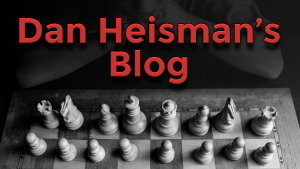Q&A with Coach Heisman Sep 28, 2012
At the end of today's show, one of my steady viewers asked if I should create a FAQ file at Chess.com so, if I kept getting the same questions, I could just refer the questioner to the file. My reply was "No, but I do get a lot of 'I am 1400. What opening should I play?'" 
To that effect I recently wrote a blog "What's a Good Opening?" at http://blog.chess.com/danheisman/whats-a-good-opening. Hopefully some of my viewers will be able to read the blog and clear up some common questions. I do feel badly for those who are desperately trying to improve and believe that which opening they pick will make the difference. After coaching about 1,000 private students, I can pretty much categorically state that the chances are slim (but not zero), but the misperception does persist.
Ironically, GM Lev Alburt must agree with me because in his book co-authored with Al Lawrence, Chess Rules of Thumb, he picks one of my lesser-known quotes "Any opening you know well is good no matter what its reputation." It's not that openings don't matter - they clearly do - but if your rating is low it's much more likely that its because you are not making safe moves or because you are not consistently getting your pieces out than which opening you choose.
If you can consistently get all your pieces active in an efficient and safe manner then you are getting a lot more out of the opening than many that profess to know a multitude of opening lines. The stronger you are, the more particular opening sequences are very important. However, even a strong coach like GM Maurice Ashley stated that he did not suggest his students study particular opening sequences until they were at least 2200!
One viewer asked about getting his rooks active in the openings and this is a key point - one that I have been asked many times over the years. The key idea is called a "pawn break" or "break move". In his wonderfully instructive book Pawn Power in Chess Hans Kmoch calls this "liberating levers" but, like much of Kmoch's nomenclature, this one did not survive. Still the idea is important. Let's define a break move:
Break move - a pawn move to attack an opponent's fixed pawn so that the player making the break on the next move(s) will have the option to open (or semi-open) the file.
Break moves can be important in the opening, middlegame, and endgame. Probably the best known example of a break move in the opening is in the Advance Variation of the French Defense:
Another common break move is the Queen's Gambit:
Even the Open Sicilian is essentially a pawn break:
But in the Old Benoni Black's lever on the first move does not constitute a break move:
More on break moves at http://www.chesscafe.com/text/heisman17.pdf.
Today's show featured almost 100% questions on improvement. That's OK since that's probably what I am best known for. But it's also nice to take advantage of my other areas of "expertise":
- Member of the International Computer Chess Association (now the International Computer Game Association) since the 1970's. Worked at both Kasparov-Deep Blue matches.
- US Chess Federation Senior Tournament Director (so questions about rules are great)
- Advisor to the USCF Ratings Committee (my bachelor's is in Math). I don't do this any more but they are still friendly with me...
- Opinions on chess history and current events (I am certainly no chess historian but some of my best friends are!
 )
)
So improvement questions are great but we do want it to be a "Variety" show.
One viewer asked about improvement if a strong mentor is not available. This is a great question since one of the very best ways to improve is to hang out with strong players as much as possible. However, everyone doesn't have a strong friend or even a strong club available locally. And many who don't may not be able to afford a regular chess instructor (although many of the instructors at Chess.com are reasonably priced - check them out under pull-down menu "Learn|Online Coaching").
The good news is that the internet, especially Chess.com, is your friend and willing conduit. Beside the above-mentioned online coaching, there are literally thousands of good players willing to play you and analyze games with you. Not everyone you learn from has to be 2500+ (I should know - I'm not!). Even if you can analyze a game with someone at your own level you can "bootstrap" each other up by sharing the knowledge that the other one does not possess and push each other to learn more.
A player who is near your level and willing to work with you on chess regularly is a "study-buddy". But even without a study-buddy there are many players who are willing to review games, and even a few "know-it-alls" who are willing to help weaker players just to show how "smart" they are  . We (hopefully) don't have this latter type at the Dan Heisman Learning Center (http://www.chess.com/groups/home/dan-heisman-learning-center) of course, but we do have hundreds of players willing to play slow games and analyze them with their opponents, which is a good start.
. We (hopefully) don't have this latter type at the Dan Heisman Learning Center (http://www.chess.com/groups/home/dan-heisman-learning-center) of course, but we do have hundreds of players willing to play slow games and analyze them with their opponents, which is a good start.
Finally, I tried a different method of tracking questions: going thru the alphabet and taking questions by the first letter of a member's handle. Of all the methods I have used for the widely-viewed "anyone can view" show, this seemed to work the best. It's not perfect, but it did keep the traffic flow on the chat window under a little better control. Without some control the questioning frenzy gets out of hand, so I am working on making it as fair and easy as possible. I appreciate your help and look forward to next time...



